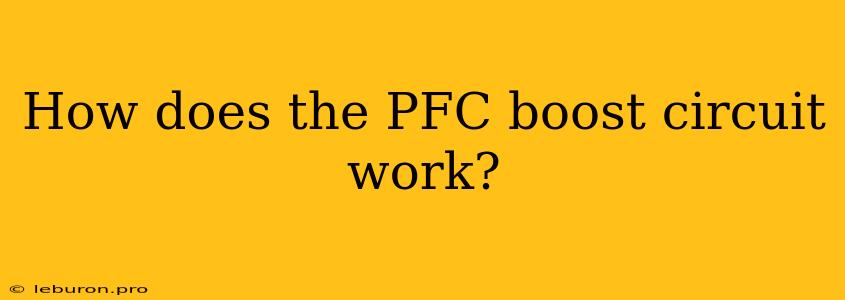Power factor correction (PFC) circuits are essential components in modern electronic devices, playing a crucial role in improving energy efficiency and reducing power losses. Understanding how these circuits operate is vital for anyone involved in electronics design or troubleshooting. This article will delve into the workings of a PFC boost circuit, explaining its fundamental principles, operation, and benefits.
What is a PFC Boost Circuit?
A PFC boost circuit is a type of power factor correction circuit that utilizes a boost converter topology to increase the power factor of an AC-to-DC power supply. It accomplishes this by drawing a nearly sinusoidal current from the AC mains, minimizing the harmonic distortion and reducing power losses. The circuit essentially converts the non-sinusoidal current drawn by the load into a near-sinusoidal current, thereby improving the power factor.
How Does a PFC Boost Circuit Work?
The operation of a PFC boost circuit can be understood by examining its key components and their interactions:
-
Rectifier: The AC input voltage is first rectified using diodes. This converts the alternating current into a pulsating DC voltage.
-
Boost Converter: The heart of the PFC boost circuit, the boost converter, is responsible for boosting the rectified DC voltage to a higher level. It consists of a switching element (usually a MOSFET), an inductor, and a capacitor. The switching element is controlled by a dedicated control circuit, which ensures efficient power transfer and regulation of the output voltage.
-
Control Circuit: The control circuit monitors the output voltage and adjusts the duty cycle of the switching element to maintain a constant output voltage and regulate the input current.
-
Output Filter: An output filter, usually composed of capacitors and inductors, is used to smooth out the output voltage and remove any remaining ripple.
Operation of the Boost Converter:
The PFC boost circuit works by using the boost converter to draw a nearly sinusoidal current from the AC mains. The boost converter operates in two modes:
-
Charging Mode: When the switching element is turned on, current flows through the inductor, charging it. This current is drawn from the rectified DC input, resulting in a rising current waveform.
-
Discharging Mode: When the switching element is turned off, the energy stored in the inductor is transferred to the output capacitor, causing the output voltage to rise. The current through the inductor is now flowing through the load.
By carefully controlling the duty cycle of the switching element, the control circuit ensures that the current drawn from the AC input closely resembles a sinusoid. The output voltage is also regulated to the desired level.
Advantages of Using a PFC Boost Circuit:
Employing a PFC boost circuit in an AC-to-DC power supply offers several advantages:
-
Improved Power Factor: By drawing a near-sinusoidal current from the AC mains, the PFC boost circuit significantly improves the power factor, approaching a value of 1. This reduces harmonic distortion and minimizes power losses.
-
Increased Efficiency: The improved power factor translates to a more efficient power conversion process. Less power is lost as heat, leading to energy savings.
-
Reduced Power Loss: The reduction in harmonic distortion minimizes the losses in the power grid, leading to a more efficient power distribution system.
-
Improved Voltage Regulation: The boost converter's ability to regulate the output voltage provides a more stable and reliable DC power supply.
-
Reduced Electromagnetic Interference (EMI): The sinusoidal current waveform generated by the PFC boost circuit reduces electromagnetic interference, leading to cleaner power operation.
Applications of PFC Boost Circuits:
PFC boost circuits are widely used in various electronic devices and systems, including:
-
Personal Computers and Servers: Modern PCs and servers typically incorporate PFC boost circuits to improve energy efficiency and reduce operating costs.
-
LCD and LED TVs: The backlight circuits in these devices often use PFC boost circuits to ensure consistent brightness and reduce power consumption.
-
Industrial Equipment: Many industrial applications, such as motors, welding machines, and power supplies, require high-power DC conversion with improved power factor, making PFC boost circuits essential.
-
Renewable Energy Systems: In solar and wind energy systems, PFC boost circuits are employed to efficiently convert the variable DC output into a stable AC supply.
-
Data Centers: With increasing demand for data processing, data centers are adopting PFC boost circuits to optimize energy efficiency and minimize operating expenses.
Conclusion:
The PFC boost circuit is an indispensable component for improving the power factor in AC-to-DC power supplies. It plays a critical role in enhancing energy efficiency, reducing power losses, and ensuring reliable operation in modern electronic devices. By understanding its fundamental principles and operation, engineers and technicians can effectively design, troubleshoot, and optimize power conversion systems for various applications.
